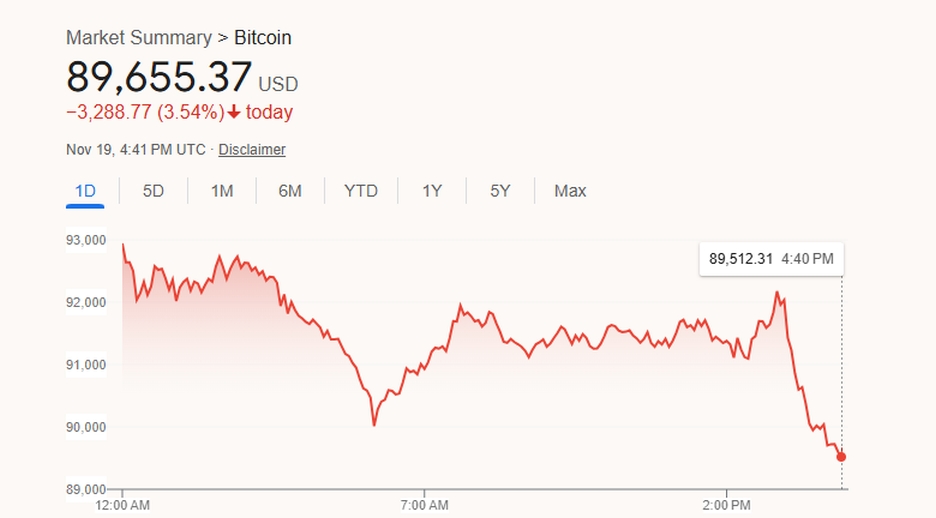Bitcoin crashes from $126,000 to $89,500 as short-term holders dump BTC — new data reveals the real trigger behind the sell-off

Bitcoin’s slide over the past week has rattled the market in a way traders haven’t felt since last year’s deep pullbacks. The drop from $126,000 to $89,512.31 didn’t just wipe out billions in paper value — it forced a harder conversation about who actually caused the meltdown. Many blamed long-term holders taking profit near cycle highs, but new on-chain data paints a very different picture.
The sell-off wasn’t led by veterans trimming exposure. It was driven by newer entrants who panicked the moment Bitcoin slipped under six figures. Bitcoin has recovered some ground and is now trading at $89,655.37.

CryptoQuant’s latest report, shared through Benzinga, shows that short-term holders — wallets holding coins for less than three months — dominated spent volume during the most aggressive parts of the decline. These traders repeatedly sold at a loss, triggering waves of forced deleveraging as liquidation bots swept through the market. The pattern didn’t resemble a disciplined distribution. It resembled fear.
“Spot Bitcoin ETFs have turned into net sellers and are absorbing none of the circulating supply. Corporate treasuries have halted accumulation — some even reduced holdings. Strategy’s recent 8,000 BTC buy is small relative to its historical activity and insufficient to offset structural outflows. Long-term holders have distributed over 800,000 BTC in 30 days, one of the largest LTH supply waves in years, while demand contracts,” Bezinga notes.
Analysts reviewing long-term holder behavior found evidence of a market top. Long-term holders have been selling since September, but the pattern looks like classic mid-cycle profit-taking. Realized Cap kept climbing through the turbulence, which signals continued new inflows strong enough to lift the overall cost basis across Bitcoin’s supply. That trend doesn’t happen if whales are hitting the exits. The missing buffer came from the other side of the curve — the short-term crowd getting flushed out.
The key moment arrived on November 14. CryptoQuant says short-term holders controlling under 1 million BTC unloaded more than 148,000 BTC in a single day at an average price of $96,853. Their cost basis sat between $102,000 and $107,000, which means this wasn’t profit-taking. It was mass loss realization triggered when Bitcoin broke below the psychological $100,000 level. Once that floor cracked, forced sellers piled in, and the market buckled.
Bitcoin managed a brief bounce above $93,000 today, but it didn’t last. Bulls lost traction almost immediately, and the price slid back toward multi-month lows near $90,000. The broader crypto market saw a similar pattern — a brief burst of green that faded just as quickly. Total market cap sits near $3.2 trillion after giving up intraday gains.
Sentiment hasn’t helped. The crypto fear and greed index sits at 15, deep in “extreme fear,” and the tone across major trading desks remains defensive. Only a handful of mid-cap tokens posted meaningful moves, and those came from project-specific catalysts, not broad risk appetite.
Bitcoin’s intraday high of $93,668 drew early interest from dip buyers, echoing last year’s pattern when aggressive traders stepped in near $80,000 before riding a strong run to new records. This time, the bid fizzled. Every attempt to reclaim overhead supply was met with renewed selling.
Some metrics briefly improved. CoinGlass data showed open interest rising 1.10% to roughly $140 billion, suggesting traders were slowly returning to leverage after heavy liquidations earlier in the week. Liquidations themselves cooled. Total 24-hour liquidations fell to $271.93 million — down sharply from the $600 million waves triggered by this week’s tariff shock.
Cooling liquidations usually help markets find a short-term footing. But momentum cracked again as soon as Bitcoin failed to clear the $93,500 level. More long positions were wiped out as short-term traders leaned too aggressively into the bounce.
Macro pressure added another layer. Renewed anxiety over President Donald Trump’s proposed tariff measure — including potential import duties of up to 500% on countries trading with Russia — shook risk assets across the board. That announcement alone sparked heavy volatility since mid-November, forcing traders out of leveraged positions across crypto majors. Analysts warn that if the measure continues advancing, the crypto market could shed another 10–20% as investors rotate into safer trades.
The rate environment hasn’t improved either. Hopes for a December rate cut have faded as inflation sticks uncomfortably high and Fed officials maintain a firm stance. Rising energy costs tied to trade tensions could complicate the inflation picture further, making risk assets feel even heavier. Reports from institutional desks point to softer inflows into spot Bitcoin products since October, leaving the market without the stabilizing force it enjoyed during the last major leg higher.
For now, Bitcoin’s next move hinges on whether buyers step back in near the lower band of recent trading ranges. Liquidation heatmaps show a dense cluster of trapped positions between $93,000 and $94,500 — a zone that has now become meaningful resistance. Tools like a comprehensive bitcoin heatmap can help traders visualize where liquidity is stacked and which levels are most likely to trigger volatility. Bulls will need to reclaim that area before any talk of recovery feels credible.




